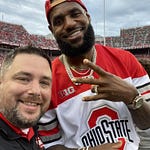ESPN Radio’s Marc Kestecher taped with us a few weeks back, and I thought this week would be a great time to release the conversation, given that he’s going to be everywhere the next couple months between ESPN’s college football game of the week and its NBA coverage.
On today’s episode:
(02:54) Kestecher shares his unlikely path to success, describing himself as usually unlucky except in his career
(03:08) Started as a local broadcaster in Albany and Cleveland
(03:57) First big break came filling in for Rich Eisen on Yankees-Red Sox game where Pedro Martinez struck out 17
(04:47) Created demo tape by calling a 76ers game with Fred Carter, who helped for free
(05:18) Got first ESPN opportunity calling Jimmy V Classic on espnradio.com
(05:35) Major career advancement came on his 40th birthday, filling in for Jim Durham on Pistons-Hornets game
(06:01) Positioned himself as studio host since 2004, staying close to national play-by-play
(06:26) Became lead NBA voice after transitions of Mike Tirico and Kevin Calabro
(09:41) Discusses importance of believing in yourself: "You almost have to have this belief that you're just as good as anyone out there"
(13:25) Describes finding his broadcasting voice through experience and repetition
(14:55) Pivotal moment when a producer told him "you have a sound now"
(16:08) Emphasizes the value of "less is more" in broadcasting, especially on radio
(18:24) Details the balance between hometown radio style and network TV approach
(19:42) Discusses working relationship with analysts John Barry and PJ Carlesimo
(20:37) Explains "DVR mode" - ability to recreate plays when analyst goes long
(23:34) Shares techniques for managing voice and energy during big moments
(24:31) Early career lesson about giving equal energy to both teams' highlights
(26:22) Discusses voice control techniques learned from Dan Schulman
(32:48) Details his pre-game preparation routine, including 20-minute focus period
(33:34) Explains different preparation approaches for basketball versus football
(36:07) Describes how he organizes and prioritizes preparation materials
(38:17) Shares process of coordinating with crew to plan storytelling during broadcasts
(41:33) Discusses challenges of calling multiple sports, particularly baseball's unique demands
(44:16) Explains differences between college and pro basketball pace
(45:12) Shares continuing approach to learning football despite not playing
(47:06) Describes experiencing "blackouts" during great calls, not remembering what was said
(48:43) Details memorable Celtics-Nets playoff call with Jason Tatum game-winner
(51:34) Shares story of LeBron James game-winner against Bulls in 2015, including nearly getting crushed by celebrating players
(52:42) Discusses challenges of courtside broadcasting and using monitors
Please rate and review the podcast and let us know what you think or who you’d like to hear in the comments section below!













Share this post